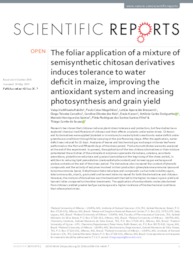The foliar application of a mixture of semisynthetic chitosan derivatives induces tolerance to water deficit in maize, improving the antioxidant system and increasing photosynthesis and grain yield.
The foliar application of a mixture of semisynthetic chitosan derivatives induces tolerance to water deficit in maize, improving the antioxidant system and increasing photosynthesis and grain yield.
Author(s): RABELO, V. M.; MAGALHAES, P. C.; BRESSANIN, L. A.; CARVALHO, D. T.; REIS, C. O.; KARAM, D.; DORIGUETTO, A. C.; SANTOS, M. H. dos; SANTOS FILHO, P. R. dos; SOUZA, T. C. de
Summary: Research has shown that chitosan induces plant stress tolerance and protection, but few studies have explored chemical modifications of chitosan and their effects on plants under water stress. Chitosan and its derivatives were applied (isolated or in mixture) to maize hybrids sensitive to water deficit under greenhouse conditions through foliar spraying at the pre-flowering stage. After the application, water deficit was induced for 15 days. Analyses of leaves and biochemical gas exchange in the ear leaf were performed on the first and fifteenth days of the stress period. Production attributes were also analysed at the end of the experiment. In general, the application of the two chitosan derivatives or their mixture potentiated the activities of the antioxidant enzymes superoxide dismutase, catalase, ascorbate peroxidase, glutathione reductase and guaiacol peroxidase at the beginning of the stress period, in addition to reducing lipid peroxidation (malonaldehyde content) and increasing gas exchange and proline contents at the end of the stress period. The derivatives also increased the content of phenolic compounds and the activity of enzymes involved in their production (phenylalanine ammonia lyase and tyrosine ammonia lyase). Dehydroascorbate reductase and compounds such as total soluble sugars, total amino acids, starch, grain yield and harvest index increased for both the derivatives and chitosan. However, the mixture of derivatives was the treatment that led to the higher increase in grain yield and harvest index compared to the other treatments. The application of semisynthetic molecules derived from chitosan yielded greater leaf gas exchange and a higher incidence of the biochemical conditions that relieve plant stress.
Publication year: 2019
Types of publication: Journal article
Unit: Embrapa Maize & Sorghum
Keywords: Déficit hídrico, Milho, Quitosana
Observation
Some of Embrapa's publications are published as ePub files. To read them, use or download one of the following free software options to your computer or mobile device. Android: Google Play Books; IOS: iBooks; Windows and Linux: Calibre.
Access other publications
Access the Agricultural Research Database (BDPA) to consult Embrapa's full library collection and records.
Visit Embrapa Bookstore to purchase books and other publications sold by Embrapa.

